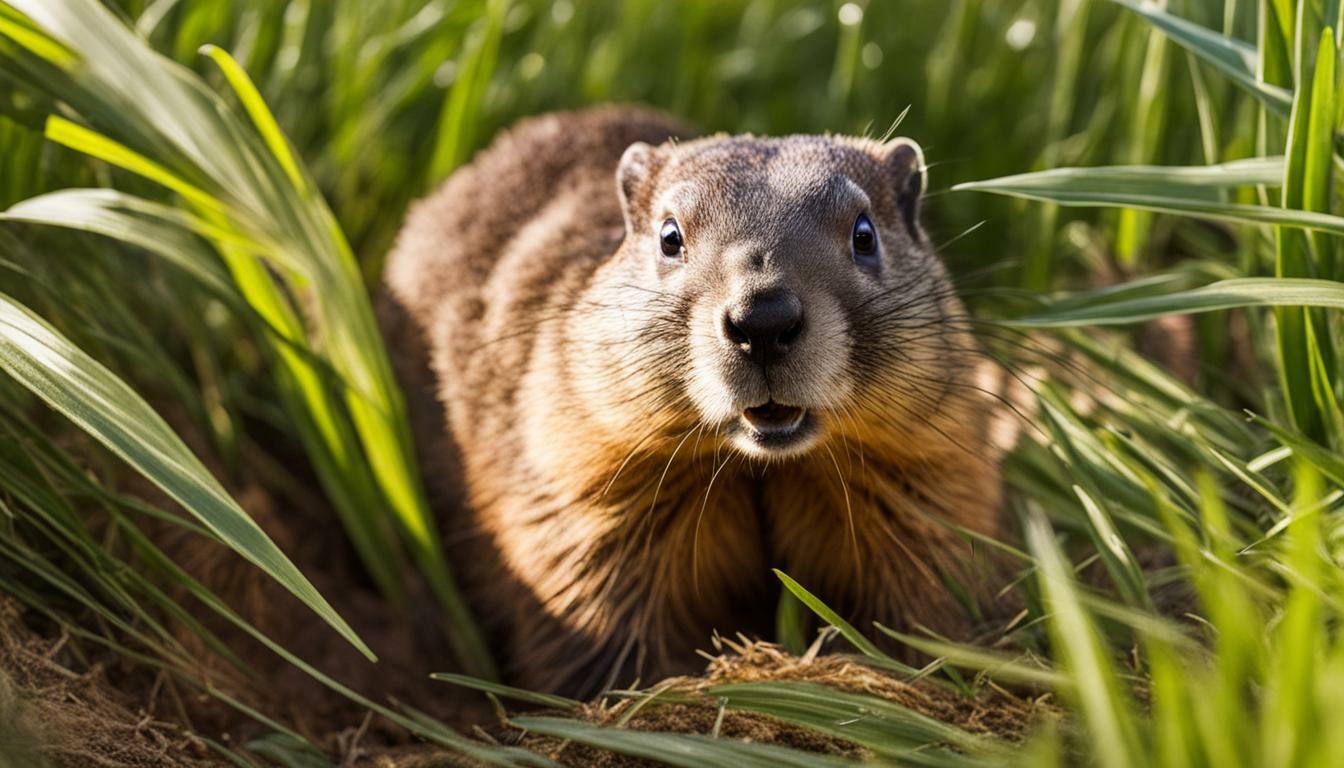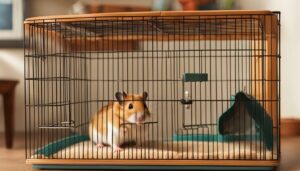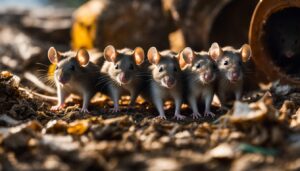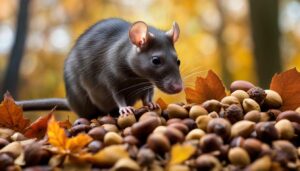If you’ve ever wondered if groundhogs live in Florida, you’re not alone. Let’s explore their presence in the Sunshine State and where you might come across them.
Key Takeaways:
- Groundhogs, also known as woodchucks or whistle pigs, do live in Florida.
- They are primarily found in the northern region of the state.
- Groundhogs are burrowing animals with features like round bodies, flat heads, and claws for digging.
- They are herbivores and eat a variety of vegetation.
- Groundhogs hibernate from fall to spring and have a lifespan of 2-6 years in the wild.
Groundhog Behavior in Florida
Groundhogs, also known as woodchucks or whistle pigs, have interesting behaviors that are worth exploring, particularly when it comes to their presence in Florida. These furry creatures are primarily found in the northern region of the state, where their burrowing nature and territorial instincts are on display. Groundhogs have round bodies, flat heads, and digging claws, which are specifically adapted for their underground lifestyles.
As herbivores, groundhogs have a diet consisting mainly of vegetation. They consume a variety of plants and grasses, which they gather during their active periods throughout the year. However, during the fall and winter months, groundhogs enter hibernation and rely on stored body fat to sustain them until spring.
During hibernation, groundhogs can remain in their burrows for several months, exhibiting a reduced heart rate and body temperature. This survival strategy helps them conserve energy during the colder months when food is scarce. Groundhogs typically emerge from hibernation in early spring, ready to resume their active behaviors.
| Groundhog Behavior in Florida |
|---|
| Presence in Northern Florida |
| Territorial Nature |
| Protective Instincts |
| Burrowing and Digging Adaptations |
| Herbivorous Diet |
| Hibernation Habits |
Groundhogs are known for their elaborate burrow systems, which can include multiple entry and exit points. These burrows serve as both shelter and protection from predators. However, they can also cause damage to property, especially when groundhogs dig near structures. This is where control methods come into play, including destroying their dens, using fences with electric wires, and employing trapping techniques.
While it’s important to manage groundhog populations to prevent property damage, it is equally crucial to handle them humanely and ethically. Coexistence with these animals entails respecting their presence in the ecosystem and finding ways to peacefully share the environment.
Groundhog Diet in Florida
Curious about what groundhogs eat in Florida? Let’s take a look at their herbivorous diet and the types of vegetation that make up their meals.
Groundhogs have a predominantly plant-based diet, consisting primarily of grasses, leaves, and other vegetation. They are known to consume a wide variety of plants, including clover, dandelions, alfalfa, and wildflowers. These rodents are particularly fond of young tender plants, which they can easily nibble on with their sharp front teeth.
During the summer months, groundhogs feast on a variety of greens, such as lettuce, spinach, and kale. They also enjoy fruits and berries when they are in season, including strawberries, raspberries, and blackberries. Groundhogs have a preference for fresh, succulent vegetation, which provides them with the necessary nutrients and hydration.
While groundhogs do not typically dig up roots or eat bark, they may occasionally nibble on the lower branches of shrubs or trees. However, their diet mainly consists of above-ground plants and grasses.
| Vegetation | Types |
|---|---|
| Grasses | Common Bermuda grass, Kentucky bluegrass |
| Leaves | Dandelion leaves, raspberry leaves |
| Greens | Lettuce, spinach, kale |
| Fruits | Strawberries, raspberries, blackberries |
| Wildflowers | Buttercups, daisies, violets |
It’s important to note that groundhogs are primarily herbivores and do not eat meat or insects. Their dietary preferences are tailored towards the vegetation available in their habitat, ensuring they have a well-rounded diet to sustain their energy and health.
Groundhog Hibernation in Florida
Hibernation is a well-known behavior among groundhogs, but does this apply to those living in Florida as well? Let’s find out more about their hibernation habits in the Sunshine State.
Groundhogs in Florida do exhibit hibernation behavior, although it may vary slightly from their counterparts in colder regions. Typically, groundhogs in Florida enter their hibernation period from late fall to early spring, seeking shelter in their burrows to conserve energy during the cooler months.
During hibernation, groundhogs experience a significant drop in their metabolic rate and body temperature, slowing down their bodily functions to conserve energy. They enter a state of deep sleep, awakening occasionally to adjust their position or snack on stored food. However, it’s important to note that the duration and timing of hibernation for groundhogs in Florida may be influenced by the milder climate in the state.
Groundhogs prepare for hibernation by gathering and storing food in their burrows. This food cache is crucial for their survival during the winter months when sustenance is scarce. Their burrows act as a protective shelter during hibernation, shielding them from extreme temperatures and potential predators. These burrows are intricate systems, often featuring multiple entry and exit points, as well as chambers for different purposes.
| Groundhog Hibernation in Florida | |
|---|---|
| Behavior | Hibernation |
| Duration | From late fall to early spring |
| Metabolic Rate | Significant drop |
| Temperature | Decreased body temperature |
Groundhog Sightings in Florida
While groundhog sightings may not be as common in Florida as in other regions, they still occur. Let’s explore the likelihood of encountering a groundhog in the state and the population trends.
In Florida, groundhogs, also known as woodchucks or whistle pigs, are predominantly found in the northern region of the state. Their presence in other areas is relatively rare. These burrowing animals have adapted to thrive in specific habitats, such as open fields, grassy areas, and woodland edges.
Groundhogs are known for their distinctive physical features, including round bodies, flat heads, and sturdy digging claws. As herbivores, they feed on a variety of vegetation, including grasses, clover, dandelions, and other plants commonly found in Florida. Their diet primarily consists of low-growing plants.
Groundhog Population Trends in Florida
While there is limited data on the exact groundhog population in Florida, sightings and encounters have been reported by residents and wildlife enthusiasts. The population trends indicate that groundhog numbers in the state are relatively low compared to other regions where they are more prevalent.
It is important to note that groundhogs are territorial animals and can display protective behavior when they feel threatened. They create elaborate burrow systems with multiple entry and exit points, which can cause damage to property. This is why control methods such as destroying their dens, using fences with electric wires, and trapping have been employed in some areas to manage groundhog populations and mitigate potential conflicts.
However, it is crucial to handle groundhog populations humanely and ethically. Promoting coexistence with these animals and adopting practices that respect their natural habitats can help foster a balanced ecosystem in Florida.
| Key Points | Summary |
|---|---|
| Groundhog Sightings | While less common in Florida, groundhog sightings do occur, primarily in the northern region of the state. |
| Groundhog Population | Groundhog numbers in Florida are relatively low compared to other regions where they are more prevalent. |
| Groundhog Characteristics | Groundhogs have round bodies, flat heads, and claws for digging, allowing them to thrive in their habitat. |
| Groundhog Behavior | Groundhogs are territorial, burrowing animals that display protective behavior when threatened. |
| Groundhog Control Methods | Control methods include destroying dens, using fences with electric wires, and trapping to manage groundhog populations. |
| Ethical Handling | It is important to handle groundhog populations humanely and ethically, promoting coexistence with these animals. |
Groundhog Burrows in Florida
Groundhogs are known for their impressive burrow systems, but what can we expect from those found in Florida? Let’s dive into the details of groundhog burrows in the state. In Florida, groundhogs, also known as woodchucks or whistle pigs, construct elaborate underground tunnels that serve as their homes and provide protection from predators and harsh weather conditions.
Groundhog burrows in Florida are typically dug in well-drained soil, often near wooded areas or open fields. These burrows consist of a main entrance, usually concealed by nearby vegetation, and multiple exits that allow for quick escape if needed. The burrows themselves are intricate networks of tunnels that can extend several feet underground, providing the groundhogs with a complex living space.
Within the burrow system, groundhogs create different chambers for specific purposes. They have separate chambers for nesting, sleeping, storing food, and even for bathroom use. These chambers help to maintain order and maximize the efficiency of the burrow. Groundhogs are meticulous in their burrow construction, making sure each tunnel is properly reinforced to withstand cave-ins and other potential threats.
Groundhog Burrow Characteristics:
| Characteristic | Description |
|---|---|
| Multiple Entrances/Exits | Groundhog burrows in Florida have multiple entry and exit points, allowing for easy escape and access to different areas. |
| Chambers | Groundhogs create separate chambers within their burrows for nesting, sleeping, food storage, and bathroom use. |
| Tunnel Network | The burrow system consists of an intricate network of tunnels that extend several feet underground. |
| Reinforcements | Groundhogs reinforce their tunnels to prevent cave-ins and other potential dangers. |
It’s important to note that while groundhog burrows can be fascinating, they can also pose challenges for property owners. The extensive tunneling can weaken the soil and cause damage to structures, gardens, and landscaping. In Florida, there are methods available to control groundhog populations and mitigate the impact of their burrows, including destroying their dens, using fences with electric wires, or trapping them.
When dealing with groundhog populations in Florida, it’s essential to handle them humanely and ethically. Coexistence with these animals is possible if we take measures to protect our property while respecting their natural behaviors. Understanding groundhog burrows and their habits can help us find the right balance between preserving wildlife and maintaining our own spaces.
Groundhog Control Methods in Florida
While groundhogs are fascinating creatures, their burrowing behavior can sometimes pose challenges. Let’s take a closer look at the control methods employed in Florida to manage groundhog populations.
One common approach to control groundhog populations is to destroy their dens. This involves locating the burrows and filling them in or collapsing them to deter the groundhogs from returning. It is important to note that this method should be done cautiously to avoid harming the animals or causing unnecessary stress.
Another effective method is the use of fences with electric wires. Installing a sturdy fence around your property, particularly in areas where groundhogs are known to frequent, can help keep them out. Adding electric wires along the bottom of the fence can provide an additional deterrent, as the groundhogs will receive a mild shock if they attempt to dig under or climb over the barrier.
Trapping is also a common method used to control groundhog populations. Live traps can be set near burrow entrances or in areas where groundhogs are causing damage. Once trapped, the groundhogs can be safely relocated to a more suitable habitat away from residential areas. It is important to check local regulations regarding trapping and releasing wildlife before attempting this method.
| Control Method | Description |
|---|---|
| Destroying Dens | Locate and fill in or collapse groundhog burrows to deter them from returning. |
| Fences with Electric Wires | Install a sturdy fence around the property, adding electric wires along the bottom to deter groundhogs from entering. |
| Trapping | Set live traps near burrow entrances or in areas where groundhogs are causing damage, then relocate them to a more suitable habitat. |
It is important to handle groundhog populations humanely and ethically. If you are facing issues with groundhogs on your property, consider consulting with local wildlife authorities or pest control professionals who can provide guidance and assistance in managing these challenges effectively.
Ethical Handling of Groundhog Populations in Florida
As we address groundhog populations in Florida, it’s crucial to consider the ethical aspects of managing their presence and finding ways to peacefully coexist with them. While groundhogs can be a nuisance to some due to their burrowing habits and potential property damage, it’s important to approach control methods with empathy and respect for these animals.
One method of groundhog control includes destroying their dens, but it’s essential to do so humanely and with the utmost care. Before taking any action, it’s advised to consult local authorities or wildlife professionals to ensure compliance with regulations and guidelines. Fences with electric wires can also be used to deter groundhogs from entering specific areas, preventing further damage to property.
Trapping is another option for managing groundhog populations, but it should only be done as a last resort and with proper knowledge of trapping techniques. It’s crucial to use humane traps and handle captured groundhogs with care. Once trapped, it’s recommended to contact local wildlife organizations or professionals who can assist with relocation or other ethical measures.
Promoting Coexistence and Conservation
While managing groundhog populations, it’s essential to consider the importance of coexistence and conservation. Groundhogs play a vital role in their ecosystems by aerating the soil through their burrowing activities and providing habitat for other species. By preserving their natural habitats and ensuring their survival, we contribute to the overall health and balance of Florida’s wildlife.
Education and awareness are key in promoting peaceful coexistence with groundhogs. By understanding their behavior, habitat needs, and the potential benefits they bring to the environment, we can find ways to mitigate conflicts and implement long-term solutions. This may include using exclusion methods to prevent groundhogs from accessing specific areas, such as gardens or yards, without causing harm to the animals.
Ethical Groundhog Handling Benefits Everyone
By prioritizing ethical handling of groundhog populations in Florida, we not only protect these fascinating creatures but also foster a harmonious relationship between humans and wildlife. Whether through responsible control methods, conservation efforts, or education initiatives, we can create a sustainable and compassionate approach to managing groundhog populations, ensuring their survival for generations to come.
| Key Points |
|---|
| Consider ethical aspects when managing groundhog populations |
| Destroy dens and use fences with electric wires humanely |
| Trapping should be a last resort with proper knowledge |
| Promote coexistence and conservation through education |
| Preserve natural habitats and implement long-term solutions |
| Handle groundhogs ethically, prioritize their survival |
Groundhog Characteristics and Features
To truly understand why groundhogs thrive in certain habitats in Florida, it’s important to explore their physical characteristics and unique features that aid in their survival. Groundhogs, also known as woodchucks or whistle pigs, are well-adapted for their burrowing lifestyle.
These fascinating creatures have round, stocky bodies covered in dense fur, which helps to insulate them during colder months. Their flat heads, equipped with sharp incisors, are perfect for gnawing through vegetation and digging into the ground. Their strong, curved claws make it easy for them to excavate and create elaborate burrow systems.
Groundhogs are herbivores, feeding on a variety of vegetation such as grasses, clover, and dandelions. Their diet consists mainly of leafy greens, which they forage for in their surrounding habitat. This makes Florida’s lush greenery an ideal environment for their survival.
Groundhog Features:
- Round bodies and flat heads
- Dense fur for insulation
- Sharp incisors for gnawing
- Curved claws for digging
Groundhog Diet:
| Preferred Vegetation |
|---|
| Grasses |
| Clover |
| Dandelions |
| Leafy greens |
In addition to their physical adaptations and dietary preferences, groundhogs are known for their territorial nature. They mark their territories and defend them fiercely from intruders. They can also be protective of their burrows, which they construct with multiple entry and exit points for safety.
While groundhogs can cause damage to property due to their burrowing habits, it is important to handle their populations humanely and ethically. Control methods such as destroying dens, using fences with electric wires, or trapping can be employed, but care must be taken to ensure these methods do not cause harm to the animals. Promoting peaceful coexistence with groundhogs is essential for maintaining the natural balance of Florida’s ecosystems.
With their physical adaptations and unique behaviors, groundhogs have found a way to thrive in certain habitats in Florida. By understanding and appreciating these characteristics, we can foster a better understanding of these fascinating creatures and work towards maintaining harmony between humans and wildlife.
Groundhog Lifespan in the Wild
Groundhogs, like many wildlife species, have a finite lifespan in the wild. Let’s examine the factors that influence their longevity and the average lifespan of groundhogs in Florida.
The lifespan of groundhogs in the wild can vary depending on various factors, including habitat, food availability, predation, and disease. On average, groundhogs have a lifespan of 2 to 6 years in the wild.
Several factors can influence the lifespan of groundhogs in Florida. Firstly, their habitat plays a significant role. Groundhogs prefer living in areas with ample vegetation, such as meadows, fields, and woodlands. The availability of food sources directly affects their overall health and survival.
Additionally, predation is a natural threat to groundhogs. They are preyed upon by a variety of predators, including foxes, coyotes, hawks, and owls. Being aware of these predators, groundhogs have adapted to be vigilant and cautious, which can enhance their chances of survival.
| Factors Influencing Groundhog Lifespan | Average Lifespan |
|---|---|
| Habitat and Food Availability | 2 to 6 years |
| Predation |
In conclusion, groundhogs in Florida live an average of 2 to 6 years in the wild. Their longevity can be influenced by factors such as habitat, food availability, and predation. By understanding these factors, we can better appreciate the complexity of their lives and the importance of preserving their natural habitats.
Groundhog Threats and Coexistence in Florida
The presence of groundhogs in Florida may face certain threats, but by understanding these risks, we can work towards their conservation and promote harmonious coexistence. Like any wildlife species, groundhogs are susceptible to habitat loss and fragmentation due to urban development. As their natural habitats are transformed into residential and commercial areas, groundhogs may struggle to find suitable places to live and forage.
A potential threat to groundhogs in Florida is the destruction of their burrows. While these burrows can cause damage to property, it is important to find a balance between protecting infrastructure and preserving the natural behavior of these animals. Implementing humane and ethical methods for controlling groundhog populations can help mitigate conflicts, such as using fences with electric wires to deter them from specific areas.
To foster coexistence, it is crucial to educate the public about groundhog behaviors and the importance of respecting their space. Encouraging responsible land management practices, such as maintaining green spaces and creating wildlife-friendly habitats, can provide groundhogs with alternative areas to thrive.
Table: Groundhog Threats and Coexistence Strategies in Florida
| Threats | Coexistence Strategies |
|---|---|
| Habitat loss and fragmentation | Preserving natural habitats and creating wildlife-friendly areas |
| Destruction of burrows | Implementing humane and ethical control methods, such as using fences with electric wires |
| Conflict with humans | Educating the public about groundhog behaviors and promoting responsible land management practices |
By taking proactive measures and adopting a respectful approach towards groundhogs, we can ensure their survival in Florida while minimizing potential conflicts with humans. Groundhogs play an important role in the ecosystem, and their presence can be appreciated as part of the state’s biodiversity. By protecting their habitats, we contribute to the overall conservation efforts in Florida and create a healthier environment for both wildlife and people.
Conclusion
In conclusion, groundhogs do live in Florida, primarily in the northern region of the state, and have specific behavioral patterns and habitat preferences. By understanding their presence and implementing humane control methods, we can foster a balanced ecosystem while respecting their role in Florida’s wildlife.
Groundhogs, also known as woodchucks or whistle pigs, are burrowing animals with round bodies, flat heads, and claws specifically adapted for digging. They are herbivores, consuming a variety of vegetation. During the fall to spring period, groundhogs hibernate, and in the wild, they typically have a lifespan of 2-6 years.
Groundhogs are territorial by nature and can exhibit protective instincts. Due to their burrowing habits, they can create elaborate systems with multiple entry and exit points, which can sometimes result in property damage.
To manage groundhog populations in Florida, various control methods can be employed. These can include destroying their dens, using fences with electric wires as a deterrent, and employing trapping techniques. It is essential, however, to handle these animals humanely and ethically, ensuring a balance between their presence and property preservation.
FAQ
Do groundhogs live in Florida?
Yes, groundhogs do live in Florida, primarily in the northern region of the state.
What are some characteristics and features of groundhogs?
Groundhogs have round bodies, flat heads, and claws for digging.
What do groundhogs eat in Florida?
Groundhogs in Florida are herbivores and eat a variety of vegetation.
Do groundhogs hibernate in Florida?
Yes, groundhogs in Florida hibernate from fall to spring.
How long do groundhogs live in the wild?
Groundhogs in the wild have a lifespan of 2-6 years.
How do groundhogs behave in Florida?
Groundhogs in Florida are territorial and can be protective.
What kind of burrows do groundhogs create in Florida?
Groundhogs create elaborate burrow systems in Florida with multiple entry and exit points.
How can groundhog populations be controlled in Florida?
Groundhog populations in Florida can be controlled by destroying their dens, using fences with electric wires, and trapping.
How should groundhog populations be handled in Florida?
Groundhog populations in Florida should be handled humanely and ethically, promoting coexistence with these animals.
How often are groundhog sightings in Florida?
Groundhog sightings in Florida can occur, but the overall population of these animals in the state is not specified.
What are some threats to groundhogs in Florida?
Potential threats to groundhogs in Florida include habitat loss and conflicts with humans.
How can humans coexist with groundhogs in Florida?
Promoting peaceful coexistence with groundhogs in Florida involves understanding their behavior and implementing strategies to minimize damage and conflicts.




